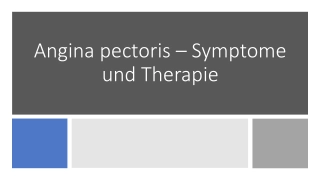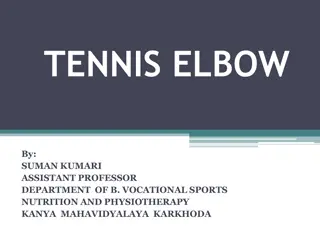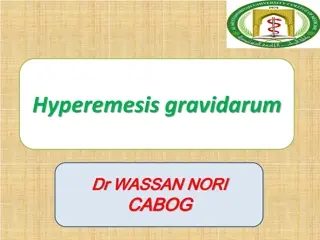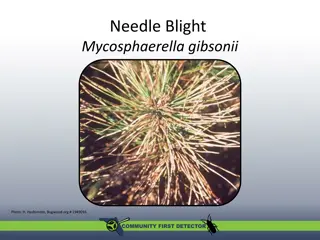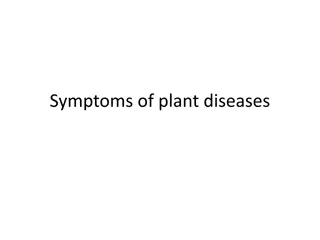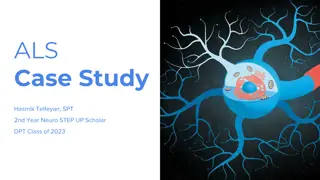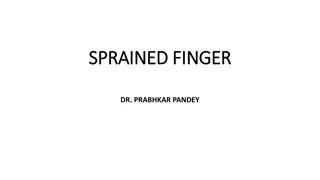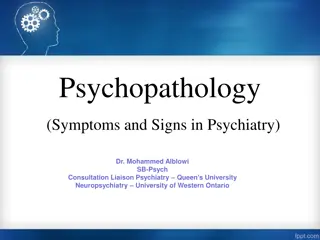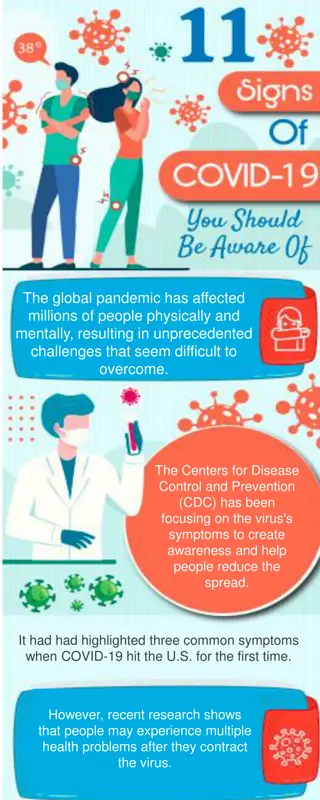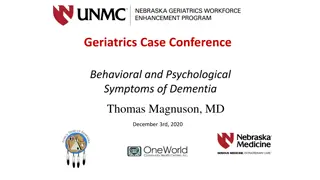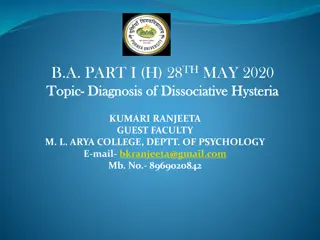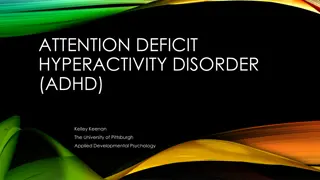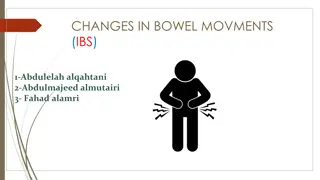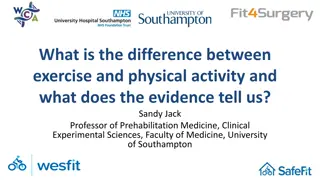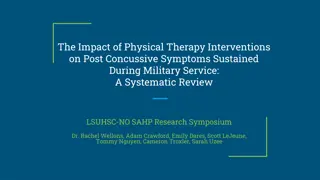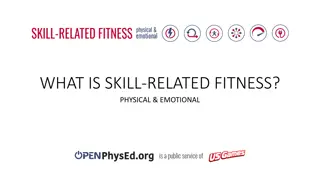Angina Pectoris: Symptoms and Therapy
The symptoms and treatment of angina pectoris, a condition characterized by chest pain and discomfort. Discover effective therapies and how to manage symptoms.
1 views • 9 slides
Physical Distribution
Physical distribution is a critical aspect of business operations involving the planning, implementation, and control of the flow of goods from origin to consumer. Philip Kotler and William J. Stanton have defined physical distribution as a process of managing the movement of goods to meet consumer
0 views • 8 slides
Exploring the Meaning and Definitions of Physical Education
Physical education involves systematic training and instruction related to physical activities for the development and maintenance of the human body. It encompasses the growth of physical power, the cultivation of physical skills, and overall enhancement of physical well-being. Various definitions h
8 views • 7 slides
Importance of Fitness Testing in Physical Education
Health-related physical activity (HRPA) stresses the need to view fitness testing as a tool to promote increased physical activity levels rather than an end goal. The focus in school physical education is on equipping youth with the knowledge and skills for lifelong health. Fitness test protocols sh
0 views • 17 slides
Addressing Functional Somatic Disorders in Patient Safety Rounds
Explore the burden of functional somatic symptoms in NS Health, delve into emotional factors contributing to somatic symptoms, and learn about evidence-based short-term talking therapy for functional somatic disorders. Gain insights from reference materials and data on unexplained symptoms and emerg
3 views • 29 slides
Understanding Pharmaceutical Degradation: Types and Factors
Pharmaceutical degradation refers to the process of a formulation in a specific container losing its chemical, microbiological, therapeutic, physical, and toxicological specifications. It can be categorized into physical, chemical, and microbiological degradation. Physical degradation alters the dru
1 views • 50 slides
Understanding Somatic Symptom Disorders, Conversion Disorders, and Dissociative Disorders
Somatic symptom disorders manifest as physical symptoms without apparent cause, while conversion disorders involve specific physical symptoms incompatible with medical conditions. Illness anxiety disorder involves interpreting normal sensations as disease symptoms. Dissociative disorders lead to a s
1 views • 41 slides
Understanding Tennis Elbow: Causes, Symptoms, and Diagnosis
Tennis elbow, or lateral epicondylitis, is a painful condition caused by overuse, with symptoms including pain on the outside of the elbow that may radiate down the forearm. Activities like tennis, golfing, and repetitive wrist movements can trigger this condition. Common symptoms include elbow pain
0 views • 10 slides
Understanding Hyperemesis Gravidarum: Symptoms, Complications, and Management
Hyperemesis gravidarum is a severe condition in pregnancy characterized by intractable nausea and vomiting, resulting in fluid and electrolyte imbalances, nutritional disturbances, and physical and psychological debilitation. The exact cause is unknown, but factors like hormonal changes, genetics, a
0 views • 22 slides
Research Work for Physical Activity Statistics in the Czech Republic
The Czech Republic excels in measures of well-being but faces challenges in income and wealth distribution. Research in physical activity statistics focuses on various aspects like strength, speed, mobility, and mental well-being. Initiatives include assessing energy expenditure from basic activitie
1 views • 23 slides
Needle Blight Mycosphaerella Gibsonii: Symptoms, Host Plants, and Management
Needle blight caused by the fungal pathogen Mycosphaerella gibsonii is a serious disease affecting various species of Pinus trees. The disease, first recorded in Japan in 1913, primarily impacts seedlings and saplings, leading to significant infection rates and death rates under epidemic conditions.
0 views • 21 slides
Understanding Poliomyelitis: Causes, Symptoms, and Prevention
Poliomyelitis, commonly known as polio, is an infectious viral disease caused by the poliovirus. It primarily affects young children, leading to the destruction of motor neurons. The disease can manifest with varying symptoms, ranging from mild flu-like symptoms to severe paralysis. Poliovirus is tr
0 views • 12 slides
Understanding Plant Diseases: Symptoms and Identification
Plant diseases induce reactions in host plants, leading to visible abnormalities known as symptoms. Common symptoms include mildew, rusts, smuts, white blisters, and blotches. Each type of disease manifests differently, such as powdery growth in mildew and pustules in rusts. Proper identification of
0 views • 171 slides
Understanding Fatigue: Causes, Symptoms, and Management
Fatigue is a distressing condition affecting physical, emotional, and cognitive aspects, often not alleviated by rest. It can be a common symptom after brain injury, spinal cord injury, and visual impairment. Symptoms include flu-like symptoms, sleep disturbances, cognitive difficulties, and emotion
0 views • 15 slides
Understanding Anemia: Causes, Symptoms, and Classification
Anemia is characterized by a reduction in hemoglobin (Hg) concentration, hematocrit (Hct) concentration, or red blood cell (RBC) count. Common symptoms include fatigue, weakness, dizziness, and palpitations. Physical signs may include pallor and tachycardia. Pica, characterized by unusual cravings,
0 views • 23 slides
Understanding Physical Fitness and its Components
Physical fitness encompasses health-related and skill-related components that contribute to overall well-being. Health-related fitness includes muscular strength, endurance, cardiorespiratory endurance, flexibility, and body composition. On the other hand, skill-related fitness comprises speed, agil
0 views • 22 slides
Understanding Peptic Ulcers: Causes, Symptoms, and Treatment
Peptic ulcers are open sores that form in the stomach or upper small intestine, leading to symptoms like stomach pain, bloating, and nausea. Common causes include H. pylori infection and NSAID use. Recognizing symptoms, such as burning stomach pain, is crucial for timely diagnosis and management. Se
0 views • 19 slides
Reimagining Physical Education: A Holistic Approach at St. Peter's Girls Prep School
In the context of St. Peter's Girls Prep School, the philosophy around physical education is explored, emphasizing the integral role it plays in a child's holistic development beyond just playing sports. The approach focuses on instilling healthy habits, balanced nutrition, and physical fitness alon
0 views • 18 slides
Understanding Somatoform Disorders: Symptoms, Diagnosis, and Treatment Options
Somatoform disorders are characterized by physical symptoms that mimic general medical conditions without an underlying medical or mental disorder. Patients often exhibit somatic symptoms without an organic basis, have poor insight, and do not find reassurance helpful. Common types include somatizat
0 views • 46 slides
Managing Menopausal Symptoms After Breast Cancer: Key Considerations
Menopausal symptoms can significantly impact the quality of life for breast cancer survivors, affecting their tolerance of treatments and overall well-being. Understanding the causes and management strategies for these symptoms is crucial to support these individuals through their post-cancer journe
0 views • 28 slides
Understanding Amyotrophic Lateral Sclerosis (ALS) and Case Study Analysis
Amyotrophic Lateral Sclerosis (ALS) is a progressive neurodegenerative disease affecting motor neurons, leading to muscle weakness and various symptoms. This case study focuses on Judy, a 52-year-old woman diagnosed with ALS, detailing her symptoms, progression, exercise routine, assistive device us
0 views • 16 slides
Understanding Medical Records: History, Physical Examination, and Abbreviations
Medical records play a crucial role in documenting a patient's medical history and findings from physical examinations. The history and physical (H&P) document includes subjective information from the patient and objective observations by the examiner. The history (Hx) record covers personal medical
0 views • 20 slides
Understanding Asthma: Symptoms, Triggers, and Management in Schools
Asthma is a common condition affecting many individuals, especially in school settings. This training aims to educate on recognizing asthma, providing support during attacks, available treatments, and school responsibilities. Asthma symptoms include coughing, wheezing, chest tightness, and shortness
0 views • 14 slides
Understanding Anaphylaxis: Symptoms, Signs, and Treatment
Anaphylaxis is a severe, life-threatening allergic reaction that can occur in response to various allergens. It manifests rapidly with symptoms like difficulty breathing, abdominal pain, skin reactions, and more. Early recognition of symptoms and prompt treatment with adrenaline are crucial for mana
0 views • 23 slides
Understanding Schizophrenia: Symptoms and Definitions
Schizophrenia is a complex mental disorder characterized by delusions, hallucinations, disorganized speech, and negative symptoms. It involves a significant decline in functioning and must persist for at least 6 months. Common terms associated with schizophrenia include catatonia, paranoia, associat
0 views • 10 slides
Understanding Sprained Fingers: Causes, Symptoms, and Treatment
A sprained finger occurs when ligaments are torn or stretched, leading to pain, swelling, and limited mobility. Sprains can range from mild to severe, with varying symptoms and degrees of instability. Common causes include physical impact or sports injuries, such as basketball. Diagnosis involves ob
0 views • 11 slides
Understanding Psychopathology: Symptoms and Signs in Psychiatry
Psychopathology involves the study of symptoms and signs in psychiatry, where signs are objective observations and symptoms are subjective experiences. Mental disorders encompass a range of issues affecting thoughts, emotions, behaviors, and relationships. Recognizing signs and symptoms such as slee
0 views • 31 slides
Understanding COVID-19 Symptoms and Differentiating from Other Illnesses
The global pandemic has brought about unprecedented challenges, with researchers updating the list of symptoms associated with COVID-19 infection. Common symptoms include fever, cough, shortness of breath, sore throat, congestion, loss of taste and smell, headache, fatigue, muscle pain, diarrhea, na
0 views • 5 slides
Importance of Physical Distancing and Basic Training Elements for COVID-19 Staff Training
Physical distancing plays a crucial role in preventing the spread of COVID-19, both at work and outside of work hours. This article emphasizes the significance of monitoring symptoms, staying home when sick, proper hygiene practices, wearing masks, and disinfection protocols. It also highlights the
0 views • 21 slides
Understanding Behavioral Symptoms of Dementia in Geriatric Patients
This informational content discusses the various behavioral and psychological symptoms of dementia (BPSD) in geriatric patients, including common symptoms like depression, aggression, anxiety, and apathy. It highlights the prevalence of behavioral issues in dementia patients, their impact on caregiv
0 views • 15 slides
Understanding Diagnosis and Treatment of Dissociative Hysteria in Psychology
The diagnosis of dissociative hysteria involves careful consideration to differentiate from organic illness. Factors such as emotional stress, time relationship with stress onset, symbolic meaning of symptoms, and course of symptoms in response to treatment play key roles in diagnosis. Psychotherapy
0 views • 6 slides
Understanding Genu Valgum: Causes, Symptoms, Diagnosis, and Treatment
Genu valgum, also known as knock knees, is characterized by inward angulation of the legs at the knee joint. This condition can arise from various factors such as rickets, growth imbalances, muscle weakness, injuries, and more. Symptoms include visual separation of the ankles, altered gait, and pote
0 views • 6 slides
Understanding ADHD: Symptoms and Classroom Strategies
This comprehensive guide explores ADHD, its symptoms of inattention and hyperactivity/impulsivity, diagnostic criteria, and classroom strategies for children affected by ADHD. The seminar objectives include defining ADHD, identifying symptoms, evaluating classroom practices, and developing ADHD-awar
0 views • 19 slides
Understanding Vaginal Symptoms in Menopause and Barriers to Treatment
The article discusses the various symptoms associated with the Genitourinary Syndrome of Menopause (GSM) such as decreased vaginal moisture, urinary frequency, and sexual difficulties. It highlights the prevalence of these symptoms in women and the barriers to seeking treatment, including discomfort
1 views • 7 slides
Importance of Physical Education in Education Code and Policies
Revised Board Policy 6142.7 and related documents highlight the significance of physical education in schools, emphasizing its role in improving physical fitness, developing motor skills, and supporting overall student well-being. The Education Code outlines requirements, exemptions, and instruction
0 views • 12 slides
Understanding Irritable Bowel Syndrome: Symptoms, Diagnosis, and Management
Define constipation and diarrhea, discuss the definition, etiology, and classification of IBS, explain how to diagnose IBS, list alarm symptoms and differential diagnosis, provide a management plan and follow-up, and recognize when to refer to a specialist. People with irritable bowel syndrome may s
0 views • 35 slides
Understanding the Difference Between Exercise and Physical Activity
In this informative content, Professor Sandy Jack explains the distinction between physical activity and exercise. Physical activity involves any movement requiring energy, while exercise is intentional, structured movement aimed at improving or maintaining physical fitness. The evidence supports th
0 views • 12 slides
Understanding the Importance of Physical Education and Exercise Science
Explore the contemporary scope of physical education & sport, emphasizing the importance of personal philosophy in this field. Discover goals for physical educators, challenges in promoting physical activity, and the expansion of physical education beyond traditional settings. Understand the impact
0 views • 12 slides
Impact of Physical Therapy on Post-Concussive Symptoms in Military Service
This systematic review explores the effects of physical therapy interventions on post-concussive symptoms in military personnel with mild traumatic brain injuries (mTBIs). It discusses the common types and symptoms of mTBIs, emphasizing the importance of a multidisciplinary approach to treatment. Ph
0 views • 32 slides
Understanding Skill-Related Fitness: Physical and Emotional Aspects
Skill-related fitness encompasses both physical and emotional components, such as agility, balance, coordination, power, reaction time, and speed. Physical agility involves quick body movements, while emotional agility relates to positive responses in various situations. Physical balance requires we
0 views • 7 slides
